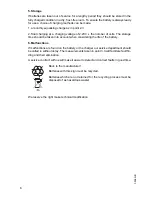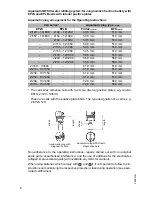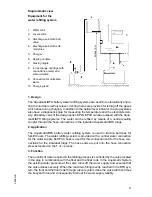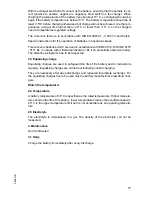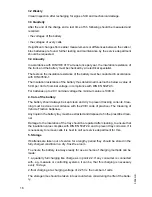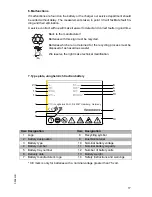
0506
.GB
4
Battery container lids and the covers of battery compartments must be opened or re-
moved. The vent plugs should stay on the cells and remain closed.
With the charger switched off connect up the battery, ensuring that the polarity is cor-
rect. (positive to positive, negative to negative). Now switch on the charger. When
charging the temperature of the electrolyte rises by about 10°C, so charging should
only begin if the electrolyte temperature is below 45°C. The electrolyte temperature
of batteries should be at least +10°C before charging otherwise a full charge will not
be achieved.
A charge is finished when the specific gravity of the electrolyte and the battery voltage
have remained constant for two hours. Special instructions for the operation of batte-
ries in hazardous areas. This concerns batteries which are used in accordance with
EN 50014, DIN VDE 0170/0171 Ex (in areas with a firedamp hazard) or Ex II (in po-
tentially explosive areas). During charging and subsequent gassing the container lids
must be removed or opened so that the explosive mixture of gases loses its flamma-
bility due to adequate ventilation. The containers for batteries with plate protection
packs must not be closed until at least half an hour after charging has past.
2.3 Equalising charge
Equalising charges are used to safeguard the life of the battery and to maintain its
capacity. They are necessary after deep discharges, repeated incomplete recharges
and charges to an IU characteristic curve. Equalising charges are carried out follo-
wing normal charging. The charging current must not exceed 5 A/100 Ah of rated ca-
pacity (end of charge - see point 2.2).
Watch the temperature!
2.4 Temperature
An electrolyte temperature of 30°C is specified as the rated temperature. Higher tem-
peratures shorten the life of the battery, lower temperatures reduce the capacity avai-
lable. 55°C is the upper temperature limit and is not acceptable as an operating tem-
perature.
2.5 Electrolyte
The rated specific gravity (S. G.) of the electrolyte is related to a temperature of 30°C
and the nominal electrolyte level in the cell in fully charged condition. Higher tempe-
ratures reduce the specified gravity of the electrolyte, lower temperatures increase it.
The temperature correction factor is -0.0007 kg/l per °C, e.g. an electrolyte specific
gravity of 1.28 kg/l at 45°C corresponds to an S.G. of 1.29 kg/l at 30°C.
The electrolyte must conform to the purity regulations in DIN 43530 part 2.
0506
.GB
4
Battery container lids and the covers of battery compartments must be opened or re-
moved. The vent plugs should stay on the cells and remain closed.
With the charger switched off connect up the battery, ensuring that the polarity is cor-
rect. (positive to positive, negative to negative). Now switch on the charger. When
charging the temperature of the electrolyte rises by about 10°C, so charging should
only begin if the electrolyte temperature is below 45°C. The electrolyte temperature
of batteries should be at least +10°C before charging otherwise a full charge will not
be achieved.
A charge is finished when the specific gravity of the electrolyte and the battery voltage
have remained constant for two hours. Special instructions for the operation of batte-
ries in hazardous areas. This concerns batteries which are used in accordance with
EN 50014, DIN VDE 0170/0171 Ex (in areas with a firedamp hazard) or Ex II (in po-
tentially explosive areas). During charging and subsequent gassing the container lids
must be removed or opened so that the explosive mixture of gases loses its flamma-
bility due to adequate ventilation. The containers for batteries with plate protection
packs must not be closed until at least half an hour after charging has past.
2.3 Equalising charge
Equalising charges are used to safeguard the life of the battery and to maintain its
capacity. They are necessary after deep discharges, repeated incomplete recharges
and charges to an IU characteristic curve. Equalising charges are carried out follo-
wing normal charging. The charging current must not exceed 5 A/100 Ah of rated ca-
pacity (end of charge - see point 2.2).
Watch the temperature!
2.4 Temperature
An electrolyte temperature of 30°C is specified as the rated temperature. Higher tem-
peratures shorten the life of the battery, lower temperatures reduce the capacity avai-
lable. 55°C is the upper temperature limit and is not acceptable as an operating tem-
perature.
2.5 Electrolyte
The rated specific gravity (S. G.) of the electrolyte is related to a temperature of 30°C
and the nominal electrolyte level in the cell in fully charged condition. Higher tempe-
ratures reduce the specified gravity of the electrolyte, lower temperatures increase it.
The temperature correction factor is -0.0007 kg/l per °C, e.g. an electrolyte specific
gravity of 1.28 kg/l at 45°C corresponds to an S.G. of 1.29 kg/l at 30°C.
The electrolyte must conform to the purity regulations in DIN 43530 part 2.
Содержание EJC M10
Страница 1: ...Operating instructions 51145321 EJC M10 G 05 09 05 09...
Страница 3: ...0108 GB...
Страница 7: ...0506 GB 2...
Страница 9: ...1004 GB A 2...
Страница 13: ...0509 GB B 4 h1 h14 h2 h3 h4 l1 l l2 h13 m2 y c Q b5 Ast W a B s...
Страница 17: ...0509 GB B 8...
Страница 21: ...0509 GB C 4...
Страница 29: ...0509 GB D 8...
Страница 32: ...E 3 0509 GB 2 1 11 3 4 5 7 6 6 8 9 10 7 6 6 8 9 10 8 9 t o...
Страница 73: ...0506 GB 18...

















